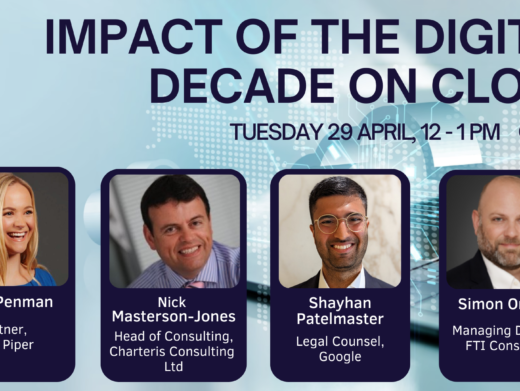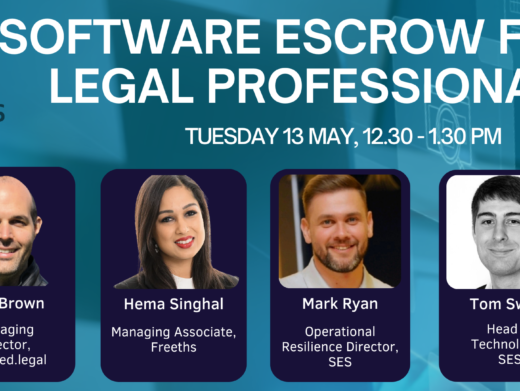On the 25th birthday of the Society it is appropriate to look back for amoment or two.
Let me start in about 1970. At that time the Law Society had a committeewhich was looking at the possible uses of computers in a solicitor’s office,but, as far as I can recollect, the focus of its deliberations was ontime-recording and on accounting systems. But there were many groups of peoplewho were pointing the way to a wider range of possibilities. Let me refer to afew of these groups:
- In Scotland Colin Campbell, who was then a member of the Law Faculty in Edinburgh, organised a conference which led to the formation of the Scottish Legal Computer Law Trust and the publication of a report by Colin Campbell, Bill Aitken and Richard Morgan, Computers for Lawyers.
- Meanwhile in England, starting, I believe, as long ago as 1967, Professor Bryan Niblett had aroused the interest of Norman Nunn-Price in computing. Norman had been working on shock waves and plasma physics at Harwell and Culham, and it was at Harwell that the two pioneers developed the Status project for the retrieval by computer of legal data relating to atomic energy.
- In New York a legal information system was made available in the early 1960s by a firm called Law Research Services Inc. but the enterprise foundered in a welter of litigation with which I need not trouble you further. It was not until later in that decade that the Ohio Bar Association decided to sponsor a new full-text retrieval system which eventually developed into the Lexis system. It is interesting to remember that it was not until 1976 that Lexis added the law of California to its database.
- On the continent of Europe too, information retrieval systems were being developed. Italy and Scandinavia were in the van. Indeed I remember writing in an early issue of what was then the newsletter of the Society that whereas Dr Johnson had remarked that a man who had not been to Italy ‘is always conscious of an inferiority’ in the 1970s the reverse might be true – a visit to some of the Italian centres might have led a member of the Society to experience a feeling of some inadequacy.
I have mentioned one or two of the early pioneers. There were others,including Tom Woodcock and Paul Leach of the Law Society and, of course, ourfirst chairman Alan Woods who saw the need for a body which would help tointroduce the legal profession to the new world of information technology. Andso in the autumn of 1973, culminating in the first Council meeting in December,the Society came into being under the inspiring leadership of our firstPresident, Lord Scarman, then Sir Leslie, who very sadly cannot be with ustonight.
I cannot say that in those early days the Bar played much of a part. I stillhave a copy of the notice which the Bar Council circulated to announce a meetingon computers and the law to be held in the Council Chamber of Lincoln’s Inn on20 May 1974 to be addressed by Bryan Niblett and Norman Nunn-Price who was thenstill at Harwell. A little group of seven people assembled. And four yearslater, in March 1978, when we arranged a meeting of the Bar to hear Jerry Rubinextol the virtues of Lexis, the numbers of those present had only swollen tonine, but they included three future judges – Peter Cresswell, David Eady and,I need hardly add, our revered President Mr Henry Brooke, as he then was.
Meanwhile, however, the Society as a whole was growing in strength year byyear. Conferences were held starting with a conference in Oxford as early asSeptember 1974 and in June 1977 we held our first workshop in Scotland which wasorganised by Bill Aitken whom I have already mentioned and by Sandy Weatherheadand David Andrews who was soon to become our second chairman.
But I must jump ahead. You all know the flourishing state of the Societytoday and of the dedicated work of the regional groups throughout the country. Iwant to say a word or two about the future. We have travelled a long way in thepast 25 years but it may well be that even bigger developments lie ahead. Imentioned 1976 in the context of California – 22 years ago. Twenty-two yearsfrom now takes one to 2020. I thought of 2020 last weekend when I went toAberystwyth to speak at a dinner given by the Law Society of the University ofWales. It will be in the next millennium that the students to whom I wasspeaking will be engaged in practice. The rather lengthy train journey and theacademic surroundings reminded me of the story which I expect you all know aboutthe great philosopher Ludwig Wittgenstein. He was waiting with two colleaguesfor a train to London. They were engaged in some weighty philosophical debate,perhaps exploring what Collingwood called the constellations of absolutepresuppositions. The train came in. The discussion continued and then thewhistle blew. Hurriedly the professor’s two colleagues scrambled aboard butWittgenstein himself moving more slowly was left behind. As he stood lookingabout him a woman who knew him by sight approached and to reassure him said‘Don’t worry professor, there is another train in a few minutes.’ ‘Dearlady’, he replied, ‘I know that, but the trouble is they came to see me off.’
2020. What shall we see then? I simply don’t know. But one can make one ortwo guesses about how the practice of the law may develop and how technology mayhelp.
One of the reasons litigation is so costly is because for a conventionaltrial a number of people have to gather together, perhaps a long way from theirhomes or places of work, and take part in a process in which some of them mayhave only a small role to play. Go into a court and look around. It is ratherlike a building site. One or two people at work but many of the others will beobservers looking with varying degrees of attention to what is going on. Takeout your calculator and do some arithmetic. Even a small court with £10 or £20an hour people in it will soon look quite expensive. And what of a court filledwith experts.
Some cases of course require the full panoply of a court hearing, but Ibelieve that there are many disputes which in the future will be dealt with byinteractive electronic links between the parties and the tribunal. The giving oflegal advice is likely to follow the same route and the layman will have theadditional help provided by expert systems, which like future diagnostic toolsin the medical field, will guide him not only as to the questions which he needsto ask but as to the answers which those questions should elicit.
So far I think we have only begun to explore the possibilities of artificialintelligence. The logical processes of a computer may help us to think morelogically, provided we appreciate that computers are only tools. The ability tofind key words in a database is not an end in itself. It was Oliver WendellHolmes who years ago told the story about the judge in Vermont who had to try adispute between two farmers about a damaged milk church. The judge took time toconsider the case and then announced that he had looked at the statutes andlegal textbooks and had not been able to find any reference to the word‘churn’. He therefore gave judgment for the defendant.
But properly used computers may help not only with legal drafting but alsowith statutory interpretation. I remember giving a talk in 1992 when I drewattention to a research project carried out at Erasmus University in Rotterdamon the development of a system to help the social security service in theNetherlands in the application of their social security system. And remember, asRichard Susskind has stressed in his seminal work The Future of Law,the lawyer in the next century will have to deploy his knowledge not only tosolve disputes but to avoid them. Furthermore it is probable that theprestidigital skills of the expert keyboard operator will become less soughtafter as voice recognition systems are further developed. They will enable thedictator of a document to talk in what I call joined up speech and in a mannerless like the lady who tells one about the next station on the Circle Line.
One of the reasons why knowledge of the law is confined to comparativelysmall groups of people is the fact that legal textbooks are often intimidatingin size and format and almost invariably disagreeably expensive. But access toinformation via the computer or the television screen – and the two media maysoon be one – is becoming a familiar process to large sections of thepopulation, particularly among the young, and such access has the great meritthat it can be selective. Indeed it seems to me that one of the great challengesfor all those who are engaged in the provision of legal services is to developefficient means of bringing the law and knowledge of the law closer to thegeneral public which they service. I am sure the Society can give a lead.
We live in exciting times. Perhaps in 13 months time we shall all have beenbitten by a millennium bug or be immured in lifts from which there is no easyescape. But tonight is a night of celebration. It is a delight to see so many ofyou here. Past chairmen of the Society. Members from abroad. May I mention inparticular Mr Maaldrink and his wife from the Netherlands and Mr O’Driscoll fromIreland. And I turn to our principal guests the Lord Chancellor and Lady Irvine.It is a great privilege and pleasure to have you here to join us on thisoccasion. This Society has I hope helped to make the profession aware of whattechnology can do and how it can aid access to justice. Your Department hasbecome a firm friend of the Society and we look forward to increasingco-operation as we move further into the Information Age.
Members of the Society, may I ask you to stand and drink to the health of ourguests, remembering in particular the Lord and Lady Irvine of Lairg.




